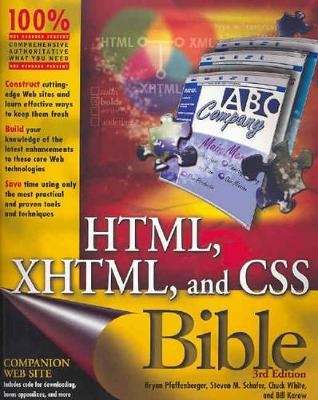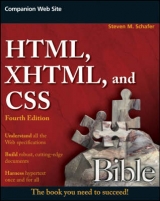
HTML, XHTML, and CSS Bible
Hungry Minds Inc,U.S.
978-0-7645-5739-2 (ISBN)
- Titel ist leider vergriffen;
keine Neuauflage - Artikel merken
An expanded, updated, and retitled edition of HTML Bible, examining HTML, XHTML-a set of extensions to HTML to make it more like XML-and cascading style sheets (CSS), which provide a simple way to add consistent formatting to HTML Web documents Focusing on reader feedback and changing industry trends, this new edition is a major overhaul that addresses the extensive changes in Web development Shows readers the best, most efficient way to use HTML and examines which peripheral technologies are worth learning for the long run Features "before and after" pictures that show the results of improved Web page coding Offers continued coverage of key topics, including site administration, dynamic data-driven pages, and many others, in addition to new sections on hot new topics such as blogs and content management
Bryan Pfaffenberger is the author of more than 75 books on computers and the Internet, including the best-selling Discover the Internet, from IDG Books Worldwide. He teaches advanced professional communication and the sociology of computing in the University of Virginia's Division of Technology, Culture, and Communication. Bryan lives in Charlottesville, Virginia, with his family and an extremely spoiled cat. Steven M. Schafer is a veteran of technology and publishing. He programs in several languages, works with a variety of technologies, and has been published in several technical publications and articles. He currently is the COOO/CTO for Progeny, and open source-based service and support company. Steven can be reach by e-mail at sschafer@synergy-tech.com. Chuck White is a Web development professional who has written numerous articles and books on Web development, including Mastering XSLT and Developing Killer Web Apps with Dreamweaver MX and C#, and tutorials for IBM DeveloperWorks. His first published work on CSS was for Web Techniques magazine in 1997, and he has been working with large and small Web sites since 1996. He is currently a Web software engineer at eBay. Bill Karow, in addition to writing several computer books, has served as a contributor or technical editor on more than 30 other books. Formerly in charge of systems development for Walt Disney Entertainment, Bill now serves as a computer consultant in the Orlando area when he's not out riding his bicycle. He also has the distinction of having stood atop many of the buildings at Walt Disney World, fanfare trumpet in hand (with their permission).
Acknowledgments. Introduction. Part I: Understanding (X)HTML. Chapter 1: Introducing the Web and HTML. Chapter 2: What Goes Into a Web Page? Chapter 3: Starting Your Web Page. Part II: HTML/XHTML Authoring Fundamentals. Chapter 4: Lines, Line Breaks, and Paragraphs. Chapter 5: Lists. Chapter 6: Images. Chapter 7: Links. Chapter 8: Text. Chapter 9: Special Characters. Chapter 10: Tables. Chapter 11: Page Layout with Tables. Chapter 12: Frames. Chapter 13: Forms. Chapter 14: Multimedia. Chapter 15: Scripts. Part III: Controlling Presentation with CSS. Chapter 16: Introducing Cascading Style Sheets. Chapter 17: Creating Style Rules. Chapter 18: Fonts. Chapter 19: Text Formatting. Chapter 20: Padding, Margins, and Borders. Chapter 21: Colors and Backgrounds. Chapter 22: Tables. Chapter 23: Element Positioning. Chapter 24: Defining Pages for Printing. Part IV: Advanced Web Authoring. Chapter 25: JavaScript. Chapter 26: Dynamic DHTML. Chapter 27: Dynamic HTML with CSS. Chapter 28: Introduction to Server-Side Scripting. Chapter 29: Introduction to Database-Driven Web Publishing. Chapter 30: Creating a Weblog. Chapter 31: Introduction to XML. Chapter 32: XML Processing and Implementations. Part V: Testing, Publishing, and Maintaining Your Site. Chapter 33: Testing and Validating Your Documents. Chapter 34: Web Development Software. Chapter 35: Choosing a Service Provider. Chapter 36: Uploading Your Site with FTP. Chapter 37: Publicizing Your Site and Building Your Audience. Chapter 38: Maintaining Your Site. Part VI: Principles of Professional Web Design and Development. Chapter 39: The Web Development Process. Chapter 40: Developing and Structuring Content. Chapter 41: Designing for Usability and Accessibility. Chapter 42: Designing for an International Audience. Chapter 43: Security. Chapter 44: Privacy. Part VII: Appendixes. Appendix A: HTML 4.01 Elements. Appendix B: CSS Properties. Index.
| Erscheint lt. Verlag | 23.7.2004 |
|---|---|
| Zusatzinfo | Illustrations |
| Verlagsort | Foster City |
| Sprache | englisch |
| Maße | 190 x 235 mm |
| Gewicht | 1162 g |
| Einbandart | Paperback |
| Themenwelt | Informatik ► Web / Internet ► HTML / CSS |
| ISBN-10 | 0-7645-5739-4 / 0764557394 |
| ISBN-13 | 978-0-7645-5739-2 / 9780764557392 |
| Zustand | Neuware |
| Haben Sie eine Frage zum Produkt? |
